Top attractions:
Quick Navigation
About Dachstein Mountains
What might sound like an unusual name in the German neighborhood, Dachstein Mountains are locally known as Dachsteingebirge. The reason why it gets the translation in English is its popularity. You see, the name is not the only thing, which stands out about these majestic mountains. 2,995m/9,826ft makes Hoher Dachstein peak the tallest point in both Upper Austria and Styria. Yes, you guessed it right – The Dachstein mountains is a border between the two Austrian states, plus to Salzburgerland as well.
But it is probably not the height of the mountain range making it famous but the glacier within. Dachstein Glacier could be reached with a cable car from Ramsau am Dachstein. The opportunity of the glacier being easy to access sounds really attractive, but it is so to many people. Tickets for the cable car has to be booked in advance.
Though usually, the name doesn’t come up to one’s mind together with Dachstein, technically Hallstatt lake is a part of the mountain range. Much more of the famous Salzburg lakes lies just beyond Dachstein Mountains in the legendary Salzkammergut (Salzburg lake district). In other words, this mountain range is situated in the middle of the most popular Austrian natural destinations. Even Höhe Tauern with the Grossglockner is not that far from the Dachstein Mountains. All things considered, this mountain range is one to visit.
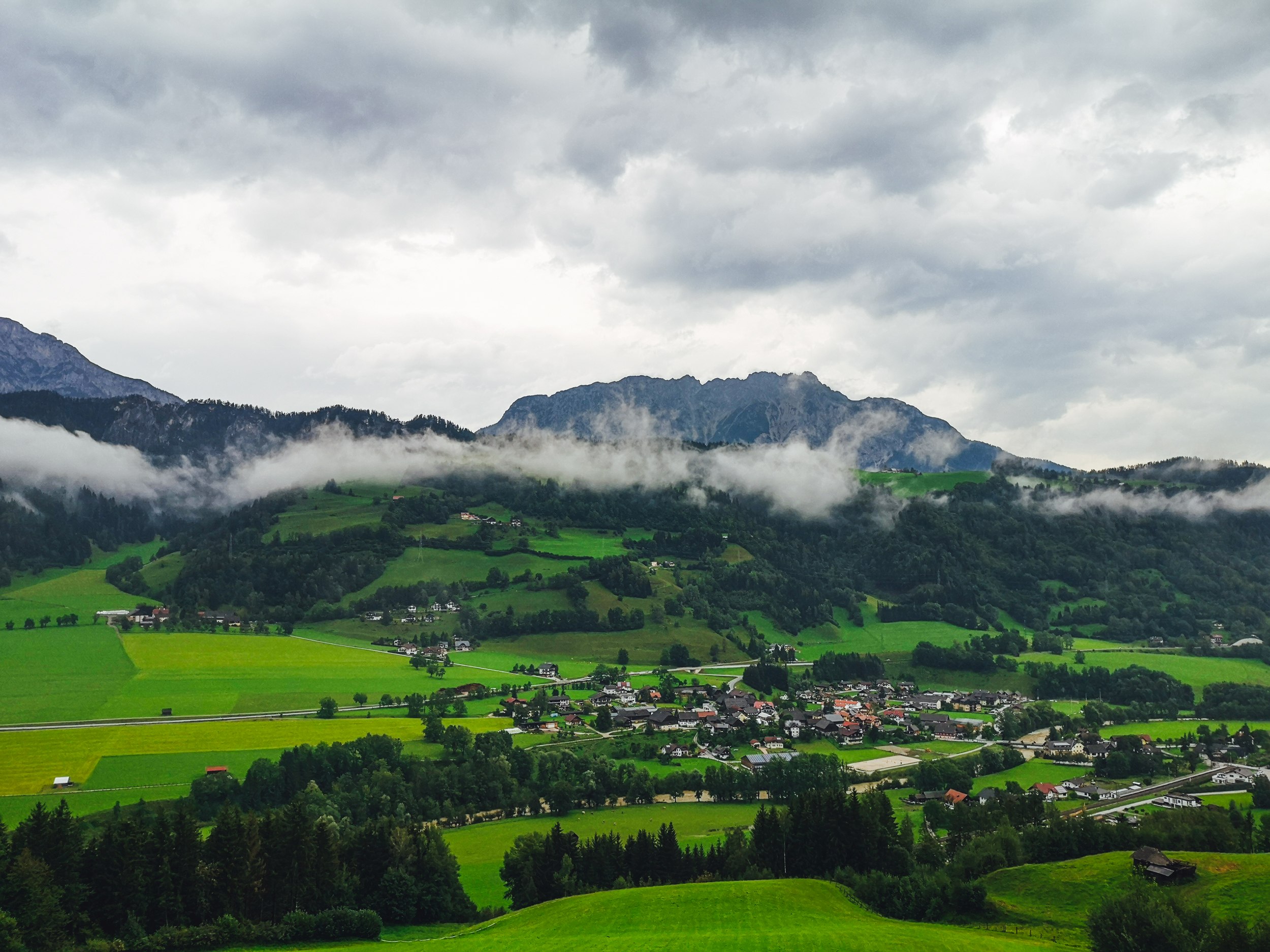
The green Enns Valley separates Dachstein Mountains from the Lower tauern. Photo by Alis Monte [CC BY-SA 4.0], via Connecting the Dots
Dachstein Mountains Details
- Location: Austria
- Region: Styria, Upper Austria and Salzburgerland
- Main hub: Ramsau am Dachstein
- Distance from Vienna: 295km / 183mi
- Distance from Graz: 173km / 107.5mi
- Distance from Salzburg: 96.4km / 59.9mi
- Length: 50km / 31mi
- Lat/Lon: 47°31″N 13°40″E
- Highest point: Höher Dachstein (2,995m / 9,826ft)
- Good accomondation: Ramsau am Dachstein, Filzmoos & Schladming
- Weather: Höher Dachstein forecast
- Emergency number: 140 and 112
Map of Schladming-Dachstein
Geography of Dachstein Mountains
What is now the mountain range used to be one big limestone massif. This type of stone is perfect from the formation of karst caves. The scientists and explorers have calculated about 450 caves within Dachstein Mountains. The most popular among them are: Mammoth Cave (length 51,3km, depth 180m) & Giant Ice Cave (length 2km, depth 70m).

One can hardly take the eyes of the Dachstein Mountains. Photo by A.L. [CC BY-SA 4.0], via Connecting the Dots
Another distinctive feature of the mountain range is the Dachstein glacier in the midst of the mountain range. Glaciers are the most erosive force in the world. The movement of the glacier, probably, shaped the sharp peaks and other features of Dachstein mountains.
This is the reason why some parts of the mountain range are located a bit further from the main massif. This includes Sarstein and Grimming. The same glacier carved out a valley, which separates the later from Totes Gebirge (eng. The Dead Mountains). One thing this mountain range has in common with Dachstein Gebirge is lack of vegetation.
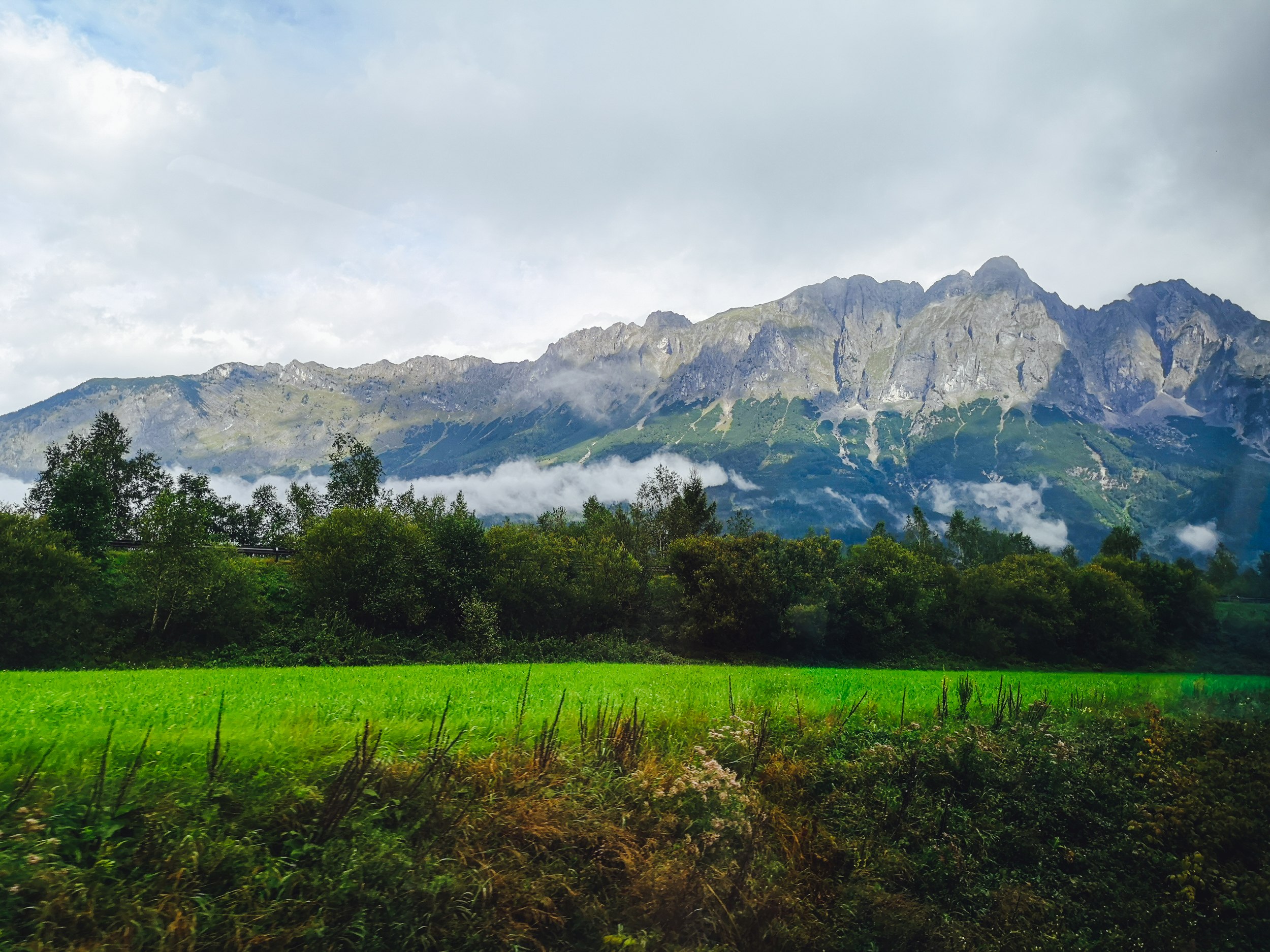
Though Grimming looks like a separate mountain because of the origins, it is considered to be a part of the Dachstein mountains. Photo by Alis Monte [CC BY-SA 4.0], via Connecting the Dots
Neighboring Mountain Ranges
- South – Niedere Tauern
- Southwest – Salzburg Slate Alps
- West – Tennen Gebirge
- Northwest – Salzkammergut Mountains
- Norteast – Totes Gebirge
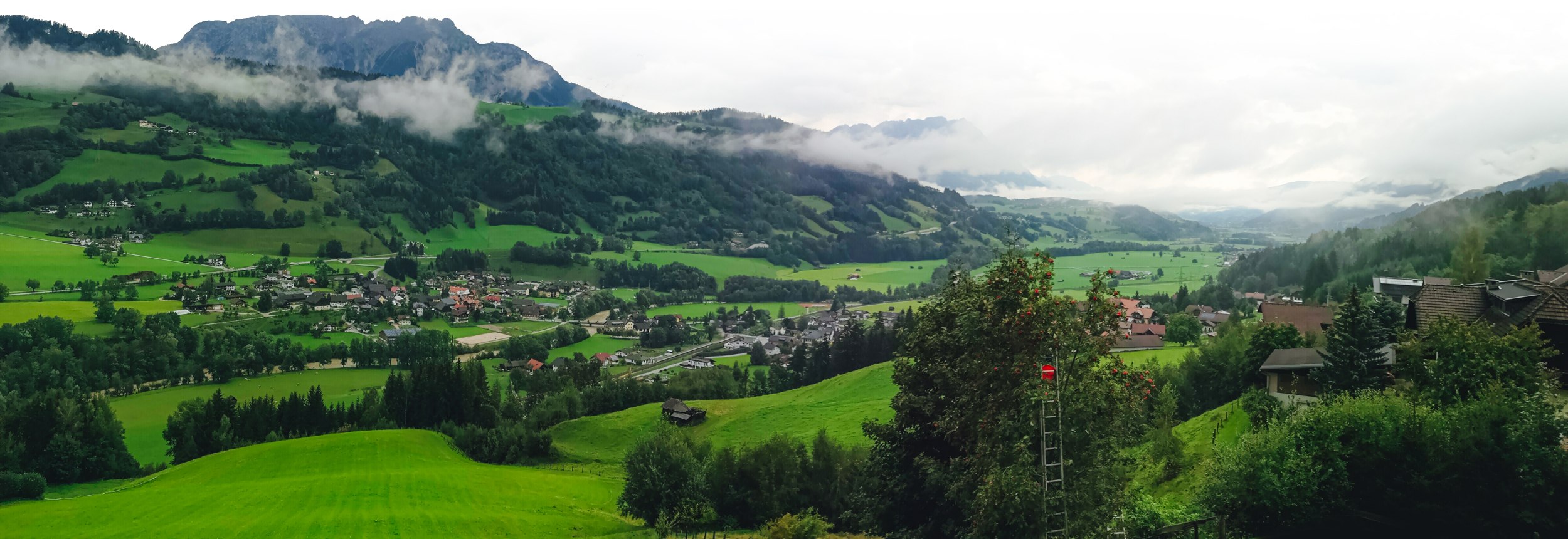
Two major peaks along the Enns Valley Mitterspitze, 2,121m (left) and Grimming, 2,351m (right). Photo by Alis Monte [CC BY-SA 4.0], via Connecting the Dots
How to get to Dachstein Mountains
I will not mention the way to reach the Dachstein Mountains from the northern side, where the Hallstatt lake is. Rather these are the directions to approach the mountains from the southeastern side – from Styria. The best hubs for adventure in the area are: Ramsau am Dachstein, Schladming, and Filzmoos.
By train
The fastest way to get to Schladming from Vienna is taking RailJet from Meidling Bahnhof to Leoben, and change to the InterCity train headed to Salzburg. The journey will take about 3h30.
It is possible to reach Schladming with Einfach-Raus Ticket, but it will take at least 5h. If you want to save some money and time – use RJ to get to Styria (starts from Semmering) and from there use the local trains with Freizeit Ticket, which costs only 11€ per person.
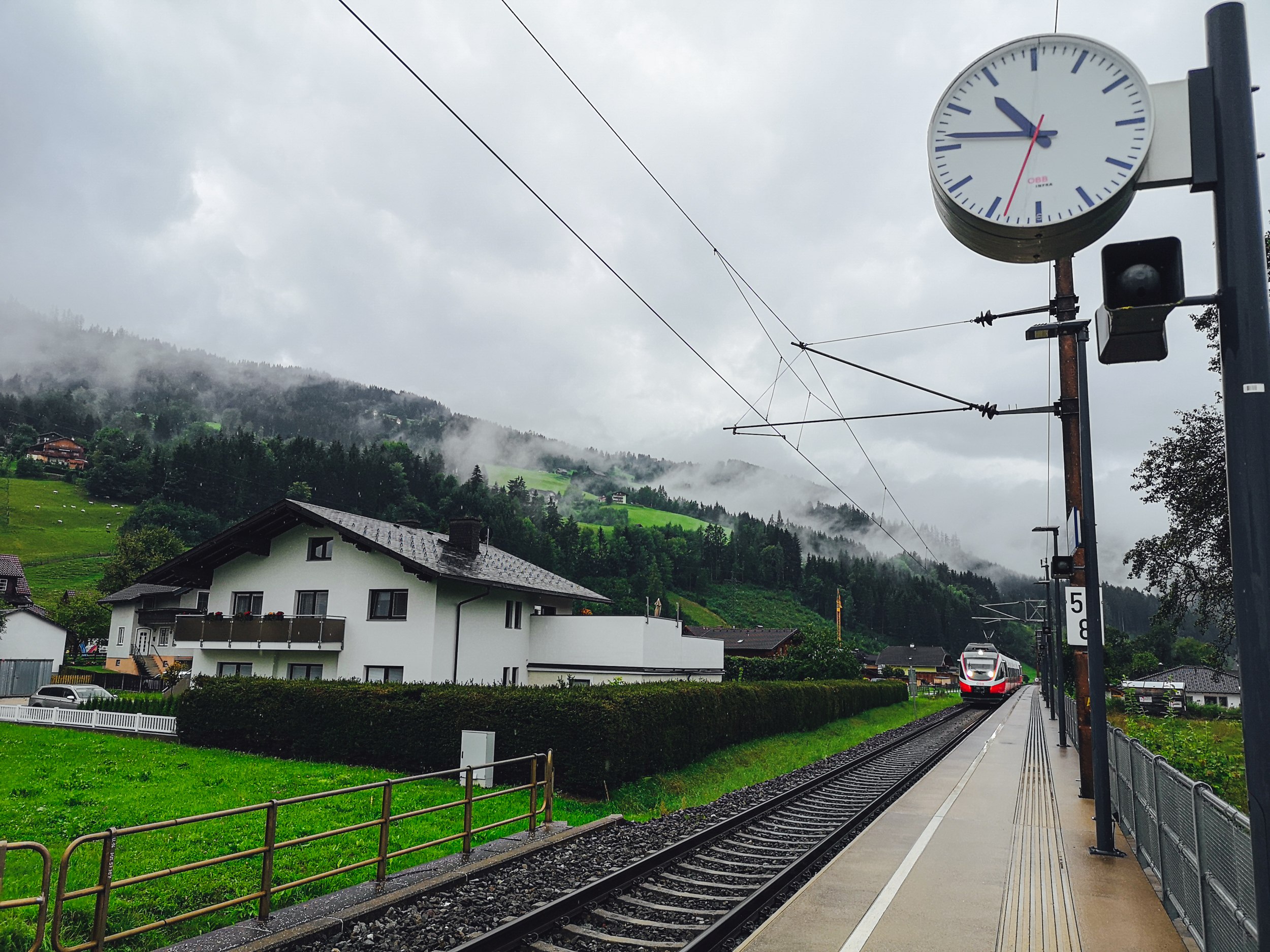
A regional train throughout the Enns Valley is scheduled every hour or so. Photo by Alis Monte [CC BY-SA 4.0], via Connecting the Dots
By car
In Vienna, seek south autobahn, road A2, and continue until Wiener Neustadt. From there keep going west on road S6 to Leoben. Don’t head south to Graz but go north towards Liezen on road A9. At the town take your final turn to head west on the road 320. You should reach Schladming in 3h30.
Things to do in Dachstein Mountains
Schladming-Dachstein Sommercard
During the summer season, between 29 May and 1st of November, most of the accommodations in the region give their clients a free Schladming Summer Card. You can find the list of Schladming-Dachstein Sommercard partners here. It is not possible to buy the card without a booking.
Dachstein Glacier
One just cannot skip the opportunity to see n alpine glacier without any effort. Cablecar to Dachstein Glacier needs to be booked in advance.
Schladming-Dachstein Sommercard: If you stay for at least two night at the same place, with Schladming Sommercard the Dachstein Glacier cable car is free.
Planai Cable Car
Though Planai is a part of the Lower Tauern, it is located in front of the main peaks of the Dachstein Mountains. The Planai Cable Car brings its visitors almost to the very top of the mountain, which could be easily reached within minutes on foot. At 1,906m / 6253ft, Planai mountain provides a beautiful panorama of both the Dachstein Mountains and the Lower Tauern.
Schladming-Dachstein Sommercard: With Schladming-Dachstein Sommercard Planai cable car could be used once for free.
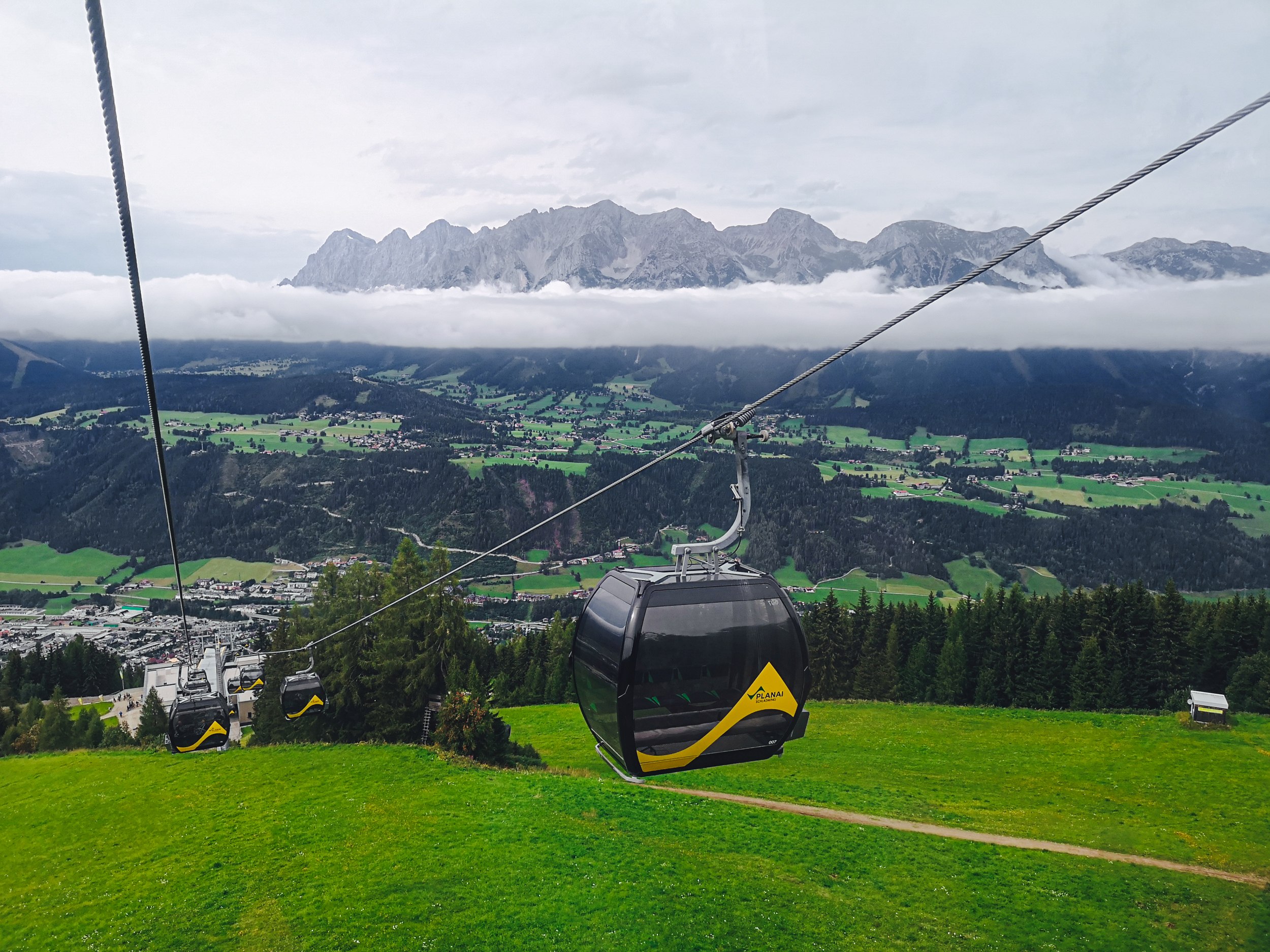
Planai Cable Car saves more than 1km of climbing. Photo by Alis Monte [CC BY-SA 4.0], via Connecting the Dots
Dachstein Giant Ice Cave
The beauty of the cave speaks for itself. A good place to see the force of the ice shaping the mountains.
Schladming-Dachstein Sommercard: Special price for card holders.
Dachstein Mammoth Cave
Mammmoth Cave is the deepest cave in the whole Dachstein mountains. It uncovers the ancient past of its dwellers. Definitely, great for kids.
Schladming-Dachstein Sommercard: Special price for card holders.
Hallstatt Lake
I don’t think I need to point out the famous Hallstatt Lake, just want to mention that it is located within the area of Dachstein Mountain. Both giant ice cave and mammoth cave could be reached from the lake side of the mountain range.

Hallstatt is one of the most popular tourist attractions in the whole country, and rightly so. Photo by Alis Monte [CC BY-SA 4.0], via Connecting the Dots
Recommended Hotels near Dachstein Mountains
Panoramahotel Stocker ★★★ – It is a traditional Austrian guesthouse ran by a local family, located 10km / 6.2mi away from Schladming Dachstein-Tauern Ski Area. Panoramahotel Stocker gives out a free Schladming-Dachstein Sommercard to every guest staying at least one night.
The guesthouse also has an infrared cabin, a sauna, children’s playground with a trampoline, climbing tower and slide as well as petting zoo with goats, rabbits and the hotel cat. Not to mention 4-star-like breakfast, included in the booking’s price. The dinner needs to be ordered in advance as there is no restaurant on the spot.

Panoramahotel has a beautiful view of the Enns Valley, Mitterspitze and Grimming mountains. Photo by Alis Monte [CC BY-SA 4.0], via Connecting the Dots
Above all is the warm welcome and the service by Stocker family. Panoramahotel definitely deserves the high ratings on booking websites and that goes without saying much about the beautiful panorama of the Dachstein Mountains.
